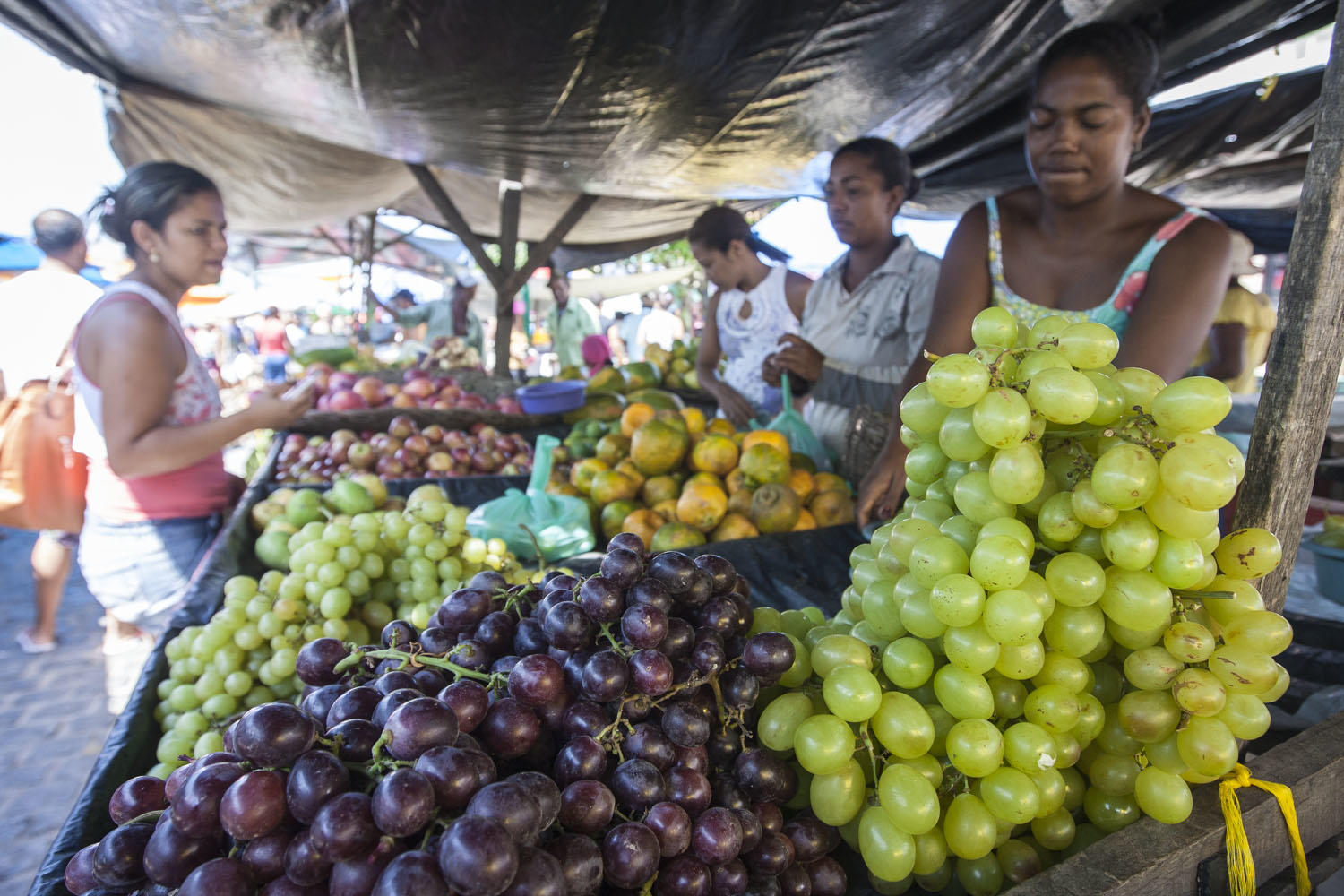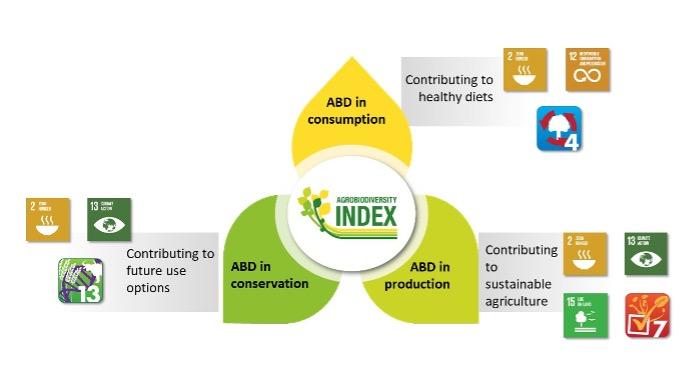Research Articles Untapped potential for agrobiodiversity to contribute to food system sustainability

The Agrobiodiversity Index provides evidence of how well the plants, animals and micro-organisms that support food and agriculture (agrobiodiversity) are used and conserved in our food systems. Using global data for 80 countries, a newly published study shows that the status of agrobiodiversity in national food systems is underutilized, and political commitments and actions aimed at enhancing this diversity need strengthening.
Key points:
- Effectively conserving and managing agrobiodiversity is critical to achieving sustainable food systems.
- The Agrobiodiversity Index measures use and conservation of the diverse plants, animals, and micro-organisms that support food and agriculture.
- By applying the Agrobiodiversity Index, a new study has found stark differences across 80 countries regarding agrobiodiversity levels in conservation, in farms, and on plates.
- Researchers recommend strengthening of political commitments and actions around agrobiodiversity.
Monitoring and maintaining agrobiodiversity is critical to achieving sustainable food systems
Globally, biodiversity is in severe decline; and this includes agrobiodiversity.
“Of more than 6,000 different plant species cultivated for food, just 9 (sugarcane, maize, rice, wheat, potatoes, soybeans, oil-palm fruit, sugarbeet and cassava) contribute around 66% of total crop production. Currently, 26% of the world’s 7,745 remaining local livestock breeds are believed to be at risk of extinction, and an estimated 33% of fish stocks are overfished”, write the authors in Nature Food.
This reliance on only a fraction of available species and varieties reduces the sustainability of our food system, and puts underused and poorly conserved species at risk of extinction.
Until now, agrobiodiversity in different parts of the food system – such as in genebanks, on farms, and on plates – was monitored separately, making it hard to see the big picture of where food systems most lack or include diversity. Yet maintaining agrobiodiversity in each part of the food system is vital to achieving sustainable food systems, as each contributes to different sustainability outcomes (see Figure 1).

Figure 1: The Agrobiodiversity Index conceptual framework for how agrobiodiversity contributes to sustainability outcomes across the three pillars of the food system (consumption, production and conservation). This includes contributions to Sustainable Development Goals 2,12, 13 and 15, and Aichi targets 4, 7 and 13 (and their successors encapsulated in the CBD post-2020 framework).
Why we need the Agrobiodiversity Index
The Agrobiodiversity Index fills this gap by collating data on agrobiodiversity: in consumption where it contributes to healthy diets, in production where it contributes to sustainable agriculture, and in conservation where it contributes to maintaining future use options.
“If we want to integrate agrobiodiversity into sustainability agendas, we need to understand how it can contribute and where it is underutilized across the food system,”
explains Sarah Jones, scientist at the Alliance of Bioversity International and CIAT, who led the analysis.
Applying the Agrobiodiversity Index to countries around the world, the paper provides a baseline to see what the data gaps are and start answering questions about how to improve the way agrobiodiversity contributes to healthy diets, sustainable agriculture, and resilient future use options.
The authors are hopeful that the research will trigger discussions in policy circles and a ‘race to the top’ to integrate agrobiodiversity-based solutions into food system policies.
The status of agrobiodiversity
Agrobiodiversity Index calculations for 80 countries show that, on average, the diversity of plants, animals and microorganisms supporting food and agriculture is well below desirable levels (average status score 56 out of 100).
This diversity is highest in consumption, reflecting, for example, high levels of food diversity available in many national markets. A low number of unique crop species in production, as well as a low proportion of cropland proximate to natural vegetation, are some of the factors accounting for lower levels of agrobiodiversity in production systems.
While some countries such as Brazil, France and Italy stand out with relatively high levels of agrobiodiversity in their food systems, work is needed to allow countries that lag behind to catch up. On the one hand, this means taking action to improve market access to nutritionally diverse foods and encourage healthy eating; a transformation in food production and land use management to increase diversity; and renewed efforts and support to conserve crop varieties, species and wild relatives in genebanks, botanical gardens and protected areas. It may also mean improving data collection, coverage and reporting to ensure that agrobiodiversity is reliably represented in global datasets.
Evidence of actions to enhance agrobiodiversity
Most countries in the analysis have taken some actions to integrate agrobiodiversity across their food system, yet more actions are needed. Also, reporting mechanisms must be improved to enable effective monitoring.
There is good news: over half of the countries surveyed have published national dietary guidelines which encourage more diverse and healthier diets. Unfortunately, most countries report on only a few of the indicators that FAO uses to monitor the conservation of plant genetic resources for food and agriculture, hampering global efforts to ensure actions are taken to safeguard these resources.
Political commitments
Most countries have made strong commitments to conserve agrobiodiversity in genebanks and off-farm as part of their national strategies and action plans (NBSAPs), but not to enhance diversity on agricultural land or in diets.
The NBSAPs set out national plans for meeting the Convention on Biological Diversity goals and targets. The upcoming COP-15 will set the post-2020 global agenda for biodiversity.
For policymakers, this is an unmissable opportunity to ensure that plans to safeguard and enhance agrobiodiversity across the whole food system are embedded into future NBSAPs. Ultimately this can help achieve biodiversity conservation and food system sustainability goals in tandem.
Next steps
Policymakers can use Agrobiodiversity Index scores as a baseline for further analysis and dialogue to pinpoint priority action areas for interventions at national and local levels.
As the authors explain,
“The data collated for our application of the Agrobiodiversity Index are globally and freely available. The approach therefore represents a fast, practical method for countries to investigate the state of their agrobiodiversity and evidence of actions to use and conserve it.”
However, concerted efforts are needed to close gaps in agrobiodiversity data availability; for example, there are no consistent global data on many relevant actions to enhance agrobiodiversity in consumption (national healthy eating campaigns, regulations to maintain diversity in school meals) or in production (uptake of intercropping, use of cover crops or cultivar mixtures).
Public research and development funding should be invested in to collect data on varietal, functional and underutilized species diversity, as well as on the distribution and outcomes of food system interventions aimed at enhancing agrobiodiversity. Effective agrobiodiversity monitoring will make it much easier for policymakers to spot the gaps and mobilize biodiversity-based solutions to achieving sustainable food systems.
